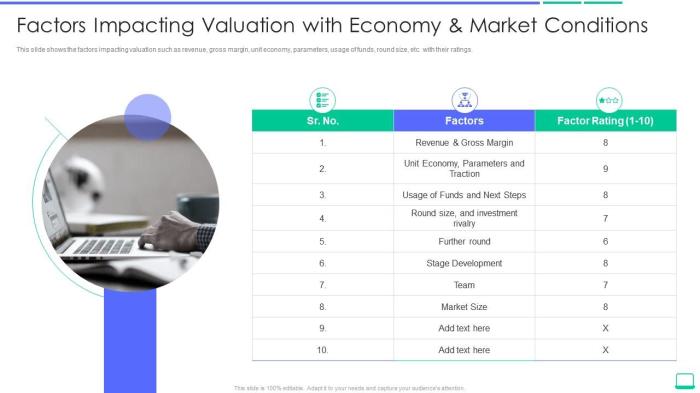The seven factors of company value are crucial for understanding how businesses are assessed. This exploration dives deep into these key components, examining everything from revenue streams and profitability to market position and future potential. We’ll uncover how each factor influences a company’s overall worth and learn how to analyze these aspects for a comprehensive understanding of business valuation.
From the fundamental definition of company value and the various methods used to assess it, we will explore the seven critical factors that drive a company’s valuation. This in-depth analysis will be a great help in evaluating the value of a company, providing insight into the key elements that impact the worth of a business.
Defining Company Value
Company valuation is a critical aspect of business analysis, investment decisions, and strategic planning. A precise understanding of a company’s worth is essential for various stakeholders, from investors seeking returns to management teams striving for growth. Accurate valuation methods allow for informed judgments about a company’s financial health, its potential for future success, and its overall attractiveness as an investment.Determining a company’s value transcends a simple calculation; it necessitates a multifaceted approach encompassing various perspectives and employing diverse valuation techniques.
This involves considering not only the financial performance but also the company’s strategic position, market dynamics, and future prospects. Understanding the nuances of these factors is vital for generating reliable and comprehensive assessments of company value.
Defining Company Value in Business Valuation
Company value, in the context of business valuation, represents the intrinsic worth of a company, reflecting its potential to generate future cash flows. This concept is multifaceted and considers various factors beyond just current financial statements. The ultimate value is determined by the present worth of anticipated future earnings and assets.
Perspectives on Company Value
Different stakeholders have varying perspectives on company value. Shareholder value emphasizes the return on investment for equity holders, focusing primarily on profits and dividends. Conversely, stakeholder value considers the broader impact on all parties involved, encompassing employees, customers, suppliers, and the community. A comprehensive valuation should ideally incorporate both perspectives, recognizing the interconnectedness of these interests.
Methods of Assessing Company Value
Several methods are employed to assess company value, each with its own strengths and weaknesses. These techniques range from analyzing historical performance to forecasting future outcomes.
- Discounted Cash Flow (DCF) Analysis: This method projects future cash flows and discounts them back to their present value using a predetermined discount rate. DCF analysis provides a robust valuation framework, incorporating projected financial performance and reflecting the time value of money. For example, a company projected to generate $100,000 in cash flow next year, discounted by a 10% rate, would be valued at a lower amount than the $100,000, accounting for the potential return on investments over time.
A common mistake in DCF analysis is using an inappropriate discount rate, which can significantly impact the valuation outcome. A reliable discount rate needs to accurately reflect the risk and opportunity cost associated with the investment.
- Comparable Company Analysis (CCA): This approach compares the company being valued to similar publicly traded companies. Analysts use valuation multiples (e.g., price-to-earnings ratio, price-to-book ratio) to derive a value estimate. This method is particularly useful when reliable financial projections are unavailable. However, finding truly comparable companies can be challenging, and market conditions can significantly influence the results. For instance, if a company’s market share is increasing rapidly, or its technological advantage is significant, the valuation multiple may not accurately reflect its intrinsic value.
- Asset-Based Valuation: This method focuses on the net asset value of the company. It assesses the fair market value of tangible assets (e.g., property, plant, and equipment) and intangible assets (e.g., patents, trademarks) to arrive at a valuation. Asset-based valuation is commonly used for companies with limited growth prospects or those facing significant liquidation. However, it doesn’t account for the potential future earnings or the market value of the company’s operations, which can lead to an undervaluation of the company’s overall worth.
Comparing and Contrasting Valuation Methods
| Valuation Method | Strengths | Weaknesses |
|---|---|---|
| Discounted Cash Flow (DCF) | Considers future cash flows, reflecting time value of money; more comprehensive; adaptable to diverse situations. | Requires accurate projections, sensitive to discount rate selection, complex to implement; potentially challenging to validate the assumptions. |
| Comparable Company Analysis (CCA) | Relatively straightforward; readily available data; useful for companies with limited financial history. | Reliance on comparable companies; potential for mismatches in growth potential, market position, or competitive landscape; may not fully capture unique aspects of the company. |
| Asset-Based Valuation | Straightforward; useful for liquidation situations; useful for companies with limited growth prospects. | Ignores intangible assets; does not account for potential future earnings; does not reflect market value of operations. |
Identifying the Seven Factors
Understanding a company’s worth hinges on identifying the key factors that contribute to its value. These factors are multifaceted, encompassing financial performance, market position, and future prospects. Analyzing each component provides a holistic view, leading to a more accurate valuation.
Seven Crucial Factors for Company Valuation, The seven factors of company value
The valuation of a company isn’t a simple calculation; it’s a complex assessment considering various influential elements. Seven key factors are vital to consider in the evaluation process. These elements encompass different aspects, ranging from financial performance to competitive standing and market conditions.
Financial Performance
Financial performance is a cornerstone of company valuation. It reflects the company’s ability to generate revenue, manage expenses, and achieve profitability. Key indicators include revenue growth, profitability margins, and cash flow generation. Strong financial performance suggests a company’s potential for future success. For instance, a company consistently exceeding earnings projections and demonstrating healthy cash flow often commands a higher valuation.
Market Position
A company’s market position plays a critical role in determining its value. This involves analyzing its market share, brand recognition, and competitive advantages. A company with a dominant market share, a strong brand reputation, and unique offerings often commands a premium valuation. For example, a company with a highly recognizable brand name, like Coca-Cola, will likely be valued higher than a lesser-known competitor due to its established brand equity and market presence.
Competitive Advantages
A company’s competitive advantages are essential to long-term success and valuation. These advantages might include proprietary technology, unique products or services, skilled workforce, or strong customer relationships. A company possessing these advantages often experiences higher profitability and sustained growth, leading to a higher valuation. For example, a company with patented technology in a rapidly growing industry will command a premium valuation compared to a company without such intellectual property.
Management Quality
The quality of a company’s management team is crucial in shaping its future prospects. A capable and experienced leadership team can drive strategic decision-making, resource allocation, and successful execution. A strong management team can lead to improved financial performance, market share gains, and increased efficiency, which ultimately translate into higher valuations. A well-managed company can effectively navigate challenges and capitalize on opportunities, demonstrating a higher degree of predictability and stability.
Future Growth Potential
The future growth potential of a company is a critical factor in determining its value. This includes assessing market trends, industry dynamics, and the company’s strategic plans for expansion. Companies with strong growth potential, often projecting significant revenue increases and market share gains, are typically valued higher than those with limited growth prospects. For example, companies in rapidly expanding markets, like renewable energy, often command higher valuations based on their projected future growth.
Economic Conditions
Economic conditions significantly impact a company’s valuation. Factors such as inflation, interest rates, and economic cycles can influence a company’s profitability and future prospects. A stable and growing economy generally creates a more favorable environment for company valuations. Recessions, on the other hand, can lead to decreased valuations as economic uncertainty and decreased consumer spending impact company performance.
Valuation Factors Table
| Factor | Description |
|---|---|
| Financial Performance | Revenue growth, profitability margins, and cash flow generation |
| Market Position | Market share, brand recognition, and competitive advantages |
| Competitive Advantages | Proprietary technology, unique products, skilled workforce, strong customer relationships |
| Management Quality | Strategic decision-making, resource allocation, and successful execution |
| Future Growth Potential | Market trends, industry dynamics, and strategic plans for expansion |
| Economic Conditions | Inflation, interest rates, and economic cycles |
Revenue Streams and Growth: The Seven Factors Of Company Value
Revenue streams are the lifeblood of any company. Understanding how these streams generate income, and how they are expected to evolve, is crucial for assessing a company’s intrinsic value. A company with strong, predictable, and diversified revenue sources typically commands a higher valuation than one reliant on a single, volatile source. This factor directly impacts investor confidence and future projections.
Importance of Revenue Streams
Revenue streams are the foundation upon which a company’s financial health rests. The nature of these streams—their predictability, growth potential, and diversification—significantly impacts the overall valuation. Companies with consistent and growing revenue streams generally exhibit greater stability and attract more investment capital.
Impact of Revenue Growth Patterns on Valuation
Revenue growth patterns directly correlate with a company’s valuation. Rapid, sustained revenue growth often signals a strong market position and high future potential, leading to higher valuation multiples. Conversely, stagnant or declining revenue growth can negatively impact valuation, as investors may perceive a lack of future prospects.
Predictable vs. Unpredictable Revenue Streams
Predictable revenue streams, such as those from established products or services with stable demand, often command higher valuations. Investors prefer predictability because it allows for more accurate financial projections and reduced risk. Companies with unpredictable revenue streams, often from newer products or services with uncertain market acceptance, face a lower valuation due to the higher risk associated with fluctuating demand.
Significance of Diverse Revenue Sources
Diversification of revenue sources is a key element in mitigating risk and enhancing company value. Reliance on a single revenue stream leaves the company vulnerable to market fluctuations or changes in consumer preferences. A diversified revenue stream provides a buffer against unforeseen circumstances and promotes long-term sustainability.
Correlation Between Revenue Growth and Valuation Multiples
The relationship between revenue growth and valuation multiples is complex and depends on various industry-specific factors. However, a general correlation can be observed. Companies with high revenue growth rates often command higher valuation multiples compared to those with slower growth rates. The following table illustrates this correlation, providing hypothetical examples:
| Revenue Growth Rate (CAGR) | Valuation Multiple (x) | Example Industry |
|---|---|---|
| 15-20% | 3-5x | Technology (Software-as-a-Service) |
| 5-10% | 2-3x | Consumer Goods (Established Brands) |
| 0-5% | 1-2x | Mature Industries (Utilities) |
Note: CAGR stands for Compound Annual Growth Rate. Valuation multiples are simplified examples and do not reflect all market factors.
Profitability and Efficiency
Profitability and efficiency are crucial factors in determining a company’s intrinsic value. A company that consistently generates profits and operates efficiently is typically more attractive to investors. This is because these traits suggest the company can generate returns on investment and deliver sustained value over time. A strong focus on both profitability and efficiency often translates into higher valuations.
Profitability Metrics
Profitability is assessed using various metrics, reflecting different aspects of a company’s financial performance. These metrics provide a comprehensive view of how effectively a company is generating profits from its operations. Understanding these metrics is essential for investors and analysts to evaluate the financial health and potential of a company.
Understanding the seven factors of company value is crucial for any business owner. But, to truly maximize your online presence and visibility, you need to optimize your website for search engines like Bing. Knowing how to add your website to Bing Webmaster Tools, for example, is a significant step in that process. This guide will walk you through the simple steps involved.
Ultimately, these technical SEO elements, combined with a deep understanding of your company’s market position and value proposition, are key to long-term success.
- Gross Profit Margin: This ratio measures the percentage of revenue remaining after deducting the cost of goods sold. A higher gross profit margin indicates that the company is efficiently managing its production costs and selling prices. For example, a company with a 40% gross profit margin retains 40 cents of every dollar in revenue after covering the cost of goods.
- Operating Profit Margin: This metric indicates the profitability of a company’s core operations. It calculates the percentage of revenue remaining after deducting both the cost of goods sold and operating expenses. A higher operating profit margin signifies that the company is effectively managing its operational expenses, which is important for valuation.
- Net Profit Margin: This is the ultimate profitability measure, showing the percentage of revenue that translates into net income after all expenses, including taxes, are deducted. A company with a high net profit margin is generating a substantial portion of revenue as profit, indicating strong financial performance.
Profitability and Company Value
Profitability is directly linked to company value. Higher profitability usually translates into higher valuations because investors anticipate future profits and the ability of the company to generate returns. A consistent history of profitability is a key factor in attracting investors and building a strong market position. Companies with a demonstrable ability to generate and maintain profits are generally perceived as more valuable.
Operational Efficiency and Valuation
Operational efficiency is another critical component in assessing company value. Efficient operations mean the company uses its resources effectively, minimizing waste and maximizing output. This translates to lower costs and higher profitability. Investors often look at operational efficiency alongside profitability when evaluating a company’s potential. For instance, a company that can achieve the same output with fewer resources is considered more valuable due to its enhanced operational efficiency.
Comparison of Profitability Ratios
Different profitability ratios offer unique insights into a company’s financial performance. Gross profit margin focuses on production costs, operating profit margin on operational efficiency, and net profit margin on overall profitability. Each ratio provides a different perspective, and a comprehensive analysis considers all these factors. For example, a high operating profit margin might be offset by high interest expenses, leading to a lower net profit margin.
Figuring out the seven factors of company value can be tricky, but understanding these elements is key. To really delve into this, exploring powerful tools like 25 awesome Google tools can be incredibly helpful. These tools can provide valuable insights that ultimately contribute to a more accurate valuation, which is essential for understanding those seven factors.
Ultimately, a thorough understanding of these seven factors remains crucial for successful business analysis.
Cost Structure and Profitability
The cost structure of a company plays a significant role in its profitability. Companies with lower costs, whether through efficient production, negotiation with suppliers, or innovative processes, tend to be more profitable. Understanding the cost structure is vital for investors, as it provides insights into a company’s long-term potential. For example, a company with a high proportion of fixed costs might face a greater risk of losses during economic downturns, while one with a high proportion of variable costs might face greater fluctuations in profitability.
Profitability and Valuation Multiples
The impact of profitability on valuation multiples is significant. Higher profitability often results in higher valuation multiples, meaning investors are willing to pay more for each unit of earnings. A company with a strong track record of consistent profitability will command a higher valuation than one with fluctuating or declining profits. The following table demonstrates how different levels of profitability can affect valuation multiples:
| Profitability Level | Valuation Multiple (Example) |
|---|---|
| High | 15x |
| Medium | 10x |
| Low | 5x |
Note: Valuation multiples are simplified examples and can vary greatly based on industry, growth potential, and other factors.
Factor 3: Market Position and Competitive Advantage
Market position and competitive advantage are crucial elements in determining a company’s intrinsic value. A strong market position translates into greater pricing power, customer loyalty, and brand recognition, all of which contribute to a higher valuation. Companies with a significant competitive edge often command premium valuations because they can consistently outperform competitors and generate higher returns for investors.Assessing a company’s market position requires a comprehensive analysis of its market share, competitive landscape, and brand strength.
The ability to defend against competitors and adapt to changing market conditions is a key indicator of a company’s long-term viability and thus its valuation. Market trends and regulations also play a significant role in shaping the competitive landscape and impacting a company’s value.
Market Share and Position
Market share and position are critical components in evaluating a company’s strength and potential. A larger market share typically suggests greater market influence and a stronger position against competitors. This translates to greater pricing power and a more stable financial performance, directly influencing investor confidence and ultimately, valuation. Companies with a dominant market share often see higher valuations due to their ability to capture a greater portion of the market’s revenue and profit potential.
Consider a company with 80% market share in a specific niche; this substantial dominance implies significant control over the market and a strong potential for future growth, leading to a higher valuation compared to competitors with a smaller market share.
Assessing Competitive Advantage
Identifying and evaluating a company’s competitive advantages is vital in determining its valuation. Companies with sustainable competitive advantages, such as proprietary technology, strong brand recognition, or superior distribution networks, often command higher valuations. These advantages allow them to outperform competitors and sustain their profitability over the long term. For example, a company with a patented technology may have a significant advantage over competitors who lack similar intellectual property.
This advantage may translate to higher profitability, market share, and eventually, a higher valuation.
Brand Presence and Valuation
A strong brand presence can significantly impact a company’s valuation. A well-recognised and trusted brand often commands higher prices for its products or services, which directly influences revenue and profitability. This brand equity adds value beyond the tangible assets of the company. Consider companies like Coca-Cola or Apple; their strong brand recognition contributes significantly to their high market valuations.
Their established brand image and customer loyalty represent a significant intangible asset that enhances the overall company value.
Impact of Market Trends and Regulations
Market trends and regulations play a significant role in shaping the competitive landscape and influencing company value. A company’s ability to adapt to evolving market trends, such as technological advancements or changing consumer preferences, directly affects its future performance and valuation. Regulations, too, can have a profound impact. Stringent environmental regulations, for example, can impact the profitability of companies in certain sectors.
Companies that can navigate these changes effectively tend to maintain a stronger market position and command higher valuations.
Competitive Advantage Comparison
The following table provides a comparative analysis of competitive advantages for different companies in various sectors.
| Company | Competitive Advantage | Sector |
|---|---|---|
| Company A | Strong distribution network, established brand | Retail |
| Company B | Patented technology, innovative products | Technology |
| Company C | Low-cost production, efficient supply chain | Manufacturing |
| Company D | Superior customer service, personalized experience | Financial Services |
This table illustrates that different competitive advantages can be relevant in different industries. Company A, for instance, might have a stronger market position in the retail sector due to its extensive distribution network and brand recognition, while Company B’s innovative products and patented technology could provide a strong competitive edge in the technology sector. Company C’s efficient supply chain and low-cost production methods could give it an advantage in manufacturing.
Company D’s focus on customer service and personalized experiences may be a key differentiator in the financial services industry.
Factor 4: Management Team and Expertise
A strong management team is crucial for a company’s success and, consequently, its valuation. The competence, experience, and leadership qualities of the individuals running the organization significantly impact investor confidence and perceived future performance. A team with a proven track record of success often commands higher valuations compared to one with less experience or questionable leadership.Effective leadership fosters a culture of innovation, efficiency, and growth, all of which contribute positively to a company’s overall value.
Strong management teams are adept at navigating challenges, adapting to market changes, and making strategic decisions that benefit the company’s long-term prospects. This ultimately translates into a higher valuation as investors recognize the team’s ability to drive profitability and sustainable growth.
Significance of a Competent Management Team in Valuation
A competent management team is essential for a company’s success and subsequent valuation. Their expertise and experience directly influence investor confidence and perceptions of future performance. A strong management team signals a company’s ability to navigate challenges, adapt to market changes, and make sound strategic decisions. This often translates into a higher valuation compared to companies with less capable or experienced leadership.
The team’s competence, therefore, is a key factor in determining the perceived value of the enterprise.
Leadership Qualities Impacting Valuation
Several leadership qualities significantly impact a company’s valuation. Visionary leadership, characterized by the ability to articulate a compelling future and inspire employees, fosters a strong organizational culture. Strategic thinking, encompassing the ability to analyze the market, identify opportunities, and develop effective plans, is crucial for long-term success. Integrity and ethical conduct build trust among stakeholders, including investors, employees, and customers.
This trust is a key component in a higher valuation.
Impact of Experience and Expertise
The experience and expertise of the management team are directly correlated with the perceived value of the company. A team with a proven track record in the industry, demonstrably capable of achieving significant results, will command a higher valuation than a team with limited experience. For example, a management team with experience in successfully launching new products or expanding into new markets is highly valued by investors.
This demonstrated expertise provides confidence in the team’s ability to drive future growth and profitability.
Role of a Strong Board of Directors
A strong board of directors plays a critical role in the valuation of a company. An independent and well-informed board provides oversight, guidance, and strategic direction to the management team. The board’s expertise and experience can enhance the company’s reputation and increase investor confidence. They provide valuable checks and balances, ensuring responsible management practices and sound financial decisions.
Their contributions are integral to the overall valuation process.
Table: Leadership Characteristics Affecting Valuation
| Leadership Characteristic | Impact on Valuation | Example |
|---|---|---|
| Visionary Leadership | Fosters confidence in the company’s future, attracting investors | Articulating a clear vision for the company’s growth and market position |
| Strategic Thinking | Demonstrates the ability to navigate challenges and seize opportunities | Developing a robust strategic plan and adapting to market changes |
| Integrity and Ethical Conduct | Builds trust among stakeholders, increasing investor confidence | Adhering to ethical business practices and transparent financial reporting |
| Proven Track Record | Signals successful execution and confidence in future performance | Demonstrating consistent growth and profitability over time |
| Experience and Expertise | Increases investor confidence in the team’s ability to execute | Possessing deep knowledge and experience in the industry |
Factor 5: Financial Strength and Stability
Financial strength is a crucial determinant of a company’s value. A company with a strong financial foundation is better equipped to weather economic storms, invest in growth opportunities, and reward investors. This stability translates directly into investor confidence and a higher valuation. A robust financial position demonstrates the company’s ability to manage its resources effectively and sustainably.Financial strength is assessed not just by current profitability but also by a company’s ability to endure through challenging times.
This includes its capacity to meet debt obligations, generate consistent cash flow, and maintain a healthy balance sheet. A company’s financial health is a key indicator of its long-term viability and potential for future success, thus impacting its market valuation.
Importance of Financial Strength in Company Valuation
Financial strength underpins a company’s ability to execute its strategies, invest in growth, and manage risk. A company’s financial stability reflects its capacity to overcome economic downturns and unforeseen events. Strong financial indicators often lead to a higher valuation as investors perceive less risk and greater future potential.
Debt Levels and Creditworthiness
Debt levels and creditworthiness are integral components of financial strength. High levels of debt can increase financial risk, potentially impacting the company’s ability to meet obligations. Conversely, low debt levels and a high credit rating suggest lower risk, which positively influences valuation. Credit ratings from agencies like Moody’s, S&P, and Fitch are critical indicators of a company’s creditworthiness and its potential impact on investment decisions.
Financial Indicators Affecting Valuation
Various financial indicators provide insights into a company’s financial health. These include key metrics such as debt-to-equity ratios, interest coverage ratios, and return on equity (ROE). These ratios reflect the company’s efficiency in using its capital, its ability to cover interest payments, and its overall profitability. A high ROE, for example, often signals strong performance and attractive investment potential.
Consistent profitability, coupled with strong cash flow generation, is often associated with higher valuation multiples.
Thinking about the seven factors of company value? Well, recent updates to Google’s Responsive Search Ads, like google responsive search ads just got more flexible , highlight how crucial ad optimization is to a company’s bottom line. Ultimately, these changes are a testament to how vital these factors remain in the modern business landscape, and how companies can use smart tools to stay competitive.
Cash Flow Generation
Cash flow is the lifeblood of any business. Consistent and substantial cash flow generation is essential for covering operational expenses, debt obligations, and future investments. Companies that generate significant free cash flow often attract higher valuations as they demonstrate a strong ability to create value and reward investors. Free cash flow, available after capital expenditures, is a crucial indicator of a company’s ability to sustain its operations and grow.
Relationship Between Financial Strength and Valuation Multiples
The table below illustrates how financial strength, as measured by key indicators, can influence valuation multiples. It’s important to note that these are illustrative examples, and the actual relationship can vary significantly depending on the industry, company specifics, and market conditions.
| Financial Strength Indicator | Description | Impact on Valuation Multiples |
|---|---|---|
| Debt-to-Equity Ratio | Measures the proportion of debt relative to equity. | Lower ratios typically indicate lower risk and potentially higher valuation multiples. |
| Interest Coverage Ratio | Indicates the company’s ability to meet interest payments. | Higher ratios suggest a greater capacity to cover debt obligations, positively influencing valuation multiples. |
| Return on Equity (ROE) | Measures the profitability of a company’s shareholders’ equity. | Higher ROE often correlates with higher valuation multiples, as it signifies efficient use of capital and attractive returns for investors. |
| Free Cash Flow | Cash generated by a company’s operations after deducting capital expenditures. | Strong free cash flow indicates a company’s ability to reinvest and reward investors, resulting in potentially higher valuation multiples. |
Factor 6: Asset Utilization and Efficiency
Understanding how effectively a company uses its assets is crucial for evaluating its overall value. Asset utilization, in essence, measures how efficiently a company leverages its resources to generate revenue. A company that maximizes the output from its assets is generally perceived as more valuable than one that doesn’t. This factor considers the relationship between assets and the return they generate.
The Role of Assets in Company Valuation
Assets, whether tangible (like equipment and property) or intangible (like patents and trademarks), represent a company’s resources. Their value is often reflected in the company’s ability to generate revenue and profit. The more efficiently a company uses its assets, the higher the return on investment, which directly impacts the company’s overall valuation. A company with well-maintained and utilized assets is more likely to demonstrate profitability and growth potential, making it a more attractive investment.
Asset Utilization Metrics
Several metrics can quantify asset utilization, offering insights into a company’s operational efficiency. These metrics help determine how effectively the company converts assets into revenue. Key metrics include:
- Inventory Turnover Ratio: This ratio measures how many times a company sells and replaces its inventory during a specific period. A higher ratio suggests efficient inventory management and quicker conversion of inventory into sales, which usually translates to better cash flow and profitability. For instance, a high inventory turnover ratio might indicate that a retail company is effectively managing its stock and meeting customer demand, leading to higher sales and potentially greater company value.
- Fixed Asset Turnover Ratio: This ratio indicates how efficiently a company uses its fixed assets (like equipment and property) to generate revenue. A higher ratio implies that the company is effectively utilizing its fixed assets to generate more revenue. A low ratio might suggest that the company has excess or underutilized fixed assets, potentially impacting profitability and company valuation.
- Accounts Receivable Turnover Ratio: This ratio shows how quickly a company collects payments from its customers. A higher ratio indicates efficient credit and collection policies, implying a healthier cash flow. A slow turnover could indicate potential issues with credit risk, impacting profitability and potentially the valuation.
The Connection Between Asset Efficiency and Company Value
Asset efficiency is directly linked to company value. A company with high asset utilization typically generates higher returns on investment, indicating greater profitability and growth potential. This translates into a stronger financial position, making the company more attractive to investors and increasing its market value. Investors look for companies that efficiently use their resources to generate revenue, as it suggests sustainable profitability and future growth.
The Importance of Fixed Asset Management
Proper management of fixed assets is crucial for maintaining operational efficiency. This includes ensuring that assets are maintained in good working order, avoiding unnecessary depreciation, and optimizing their utilization. Efficient fixed asset management directly impacts a company’s profitability and ultimately its valuation.
Table: How Asset Utilization Affects Valuation
| Asset Utilization | Impact on Valuation |
|---|---|
| High | Increased profitability, higher growth potential, potentially higher valuation |
| Low | Lower profitability, reduced growth potential, potentially lower valuation |
A company that effectively manages and utilizes its assets will typically see a positive impact on its overall valuation.
Factor 7: Future Growth Potential and Opportunities

Future growth potential is a crucial aspect of company valuation, reflecting the company’s ability to capitalize on emerging opportunities and adapt to evolving market dynamics. A strong future outlook often translates to higher valuations, as investors anticipate substantial returns on their investment. This factor considers the potential for increased revenue, market share gains, and enhanced profitability stemming from innovative strategies and adept adaptation to market trends.
Future Growth Drivers
Identifying the key drivers of future growth is vital for assessing a company’s potential. These drivers can be categorized into several key areas, including technological advancements, evolving consumer preferences, and emerging market opportunities. Companies leveraging these forces often achieve significant market share gains and profit growth.
- Technological Advancements: Innovations in technology can create entirely new markets or dramatically improve existing products and services. For instance, the rise of e-commerce and mobile technology significantly impacted retail businesses, creating new avenues for revenue generation and market penetration. Companies that proactively adopt these advancements are better positioned for future growth.
- Evolving Consumer Preferences: Understanding and adapting to changing consumer demands is crucial for long-term success. For example, the increasing demand for sustainable and eco-friendly products has driven the growth of companies focused on environmentally conscious practices.
- Emerging Market Opportunities: New markets often represent substantial growth potential. Companies that can successfully enter these markets can experience rapid expansion and increased revenue streams. Consider the expansion of companies into developing nations with growing middle classes, a significant driver of global market growth.
Significance of Future Potential in Valuation
Future potential plays a pivotal role in determining a company’s valuation. Investors consider not just current performance but also the anticipated future earnings and market share gains. Companies with a strong track record of innovation and adaptation are often valued higher than those without a clear vision for the future. A strong future outlook is often a significant component of a company’s total valuation.
Role of Market Opportunities in Valuation
Market opportunities significantly influence a company’s valuation. Companies that identify and capitalize on emerging market trends, such as technological advancements or evolving consumer preferences, can experience rapid growth. The ability to anticipate and exploit these opportunities often directly correlates with a higher valuation. Analysis of market size, growth rate, and competitive landscape is crucial for understanding the value of these opportunities.
Importance of Innovation and Adaptation
Innovation and adaptation are essential for future growth and are directly reflected in a company’s valuation. Companies that consistently innovate and adapt to changing market conditions are better equipped to capitalize on opportunities and maintain a competitive edge. A company’s ability to adapt to changing consumer preferences, technological advancements, and regulatory changes is a key driver of its future value.
Significance of Strategic Plans for Growth
Clearly defined strategic plans are critical for realizing future growth potential. These plans Artikel the company’s goals, strategies, and action items for achieving its objectives. Strategic planning helps align resources and efforts toward common goals, improving the likelihood of success. Strategic plans act as a roadmap for future growth, ensuring that resources are allocated effectively.
Comparison of Growth Strategies
| Growth Strategy | Description | Advantages | Disadvantages |
|---|---|---|---|
| Market Penetration | Increasing market share within existing markets with existing products. | Leverages existing customer base, low risk. | Potential for limited growth, competition from existing players. |
| Market Development | Introducing existing products into new markets. | Expands revenue streams, access to new customer bases. | Higher risk, requires adaptation to new market conditions. |
| Product Development | Developing new products for existing markets. | Creates new revenue streams, potential for higher margins. | Higher development costs, risk of product failure. |
| Diversification | Entering new markets with new products. | Reduces reliance on single market/product, potential for significant growth. | Highest risk, requires significant resources and expertise. |
Conclusive Thoughts

In conclusion, the seven factors of company value present a multifaceted approach to understanding and assessing a company’s worth. From revenue streams and profitability to market position and future potential, each element plays a vital role in the overall valuation. A thorough analysis of these factors provides a comprehensive picture of a company’s current state and future prospects, offering valuable insights for investors, analysts, and business leaders.






